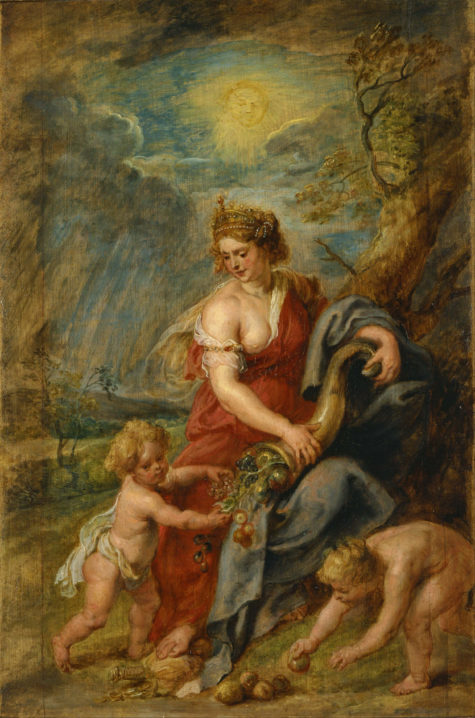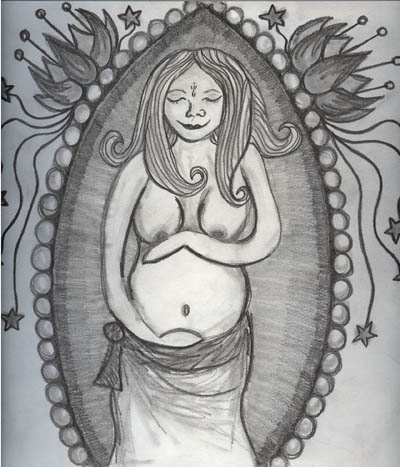The Goddess Carmenta is celebrated on two dates of the Roman calendar, (January 11 and 15), each day called Carmentalia. These dates should be considered as two separate festivals, rather than one festival extending over this period, yet it is not clear to us today, any more than it was during the Late Republic, why two such holidays should be in such close proximity in one month.
The festival, chiefly observed by women, celebrates Carmenta, who is the Goddess of women’s health, birthing, and prophecy. She is the inventor of letters, as Minerva is the inventor of numbers. She tells the future through Her sister Porrima and reveals the past through Her sister Postvorta, while Carmenta knows all that happens in the present.
Together the three Carmenae sisters are the Good Fates, the Three Mothers, and the Muses. The very name of Carmenta was given to song (carmen) and Latin terms for poetry, charms, and speaking-in-tongues. With Her songs she would soothe the ill and taught women how to care for themselves and their children. Her sanctuaries thus became places for women and children to receive traditional medical treatments using herbs and music.
Carmenta takes us back to a very early period, a time well before the beginnings of Rome around three thousand years ago, back into the Italian Bronze Age. She takes us back to the ecstatic tradition of the female priestesses called vates in which Latin religion began and in which the Religio Romana was first founded.
The sacred grove of Carmenta, the most ancient sanctuary in all of Rome, was located at the foot of the Capitoline Hill. It is still visited today where people gather waters from Her sacred spring. It was in this very grove that Carmenta appeared to Numa Pompilius in his dreams as the nymph Egeria. She instructed Numa on how to commune with the Gods.
With Egeria’s instruction, Numa Pompilius then established rituals for the Gods, festivals, and a calendar by which the Romans could attend these. Numa set out sanctuaries for Gods and Goddesses and he created colleges of priests and priestesses to serve the Gods and Goddesses. Egeria taught Numa the laws which he handed down to the Romans and which still govern our sacramental rituals today.
One of the laws of Numa states:
“The Gods are not to be represented in the form of man or beast, nor are there to be any painted or graven image of a deity admitted (to your rites).”
As one of the oldest Goddesses of Rome, whose worship was established by Numa, Carmenta was never represented by an image. It was sufficient to feel Her presence in the sacred grove below the Capitoline. In the same way, Vesta, Goddess of the Hearth, is never represented by an image but only by living fire.
Another law of Numa holds that:
“Sacrifices are not to be celebrated with an effusion of blood, but consist of flour, wine, and the least costly of offerings.”
The restriction against the use of blood sacrifices was so strong in the worship of Carmenta that no one was allowed to enter Her sacred grove wearing anything made of leather or animal hide. It is not right to take the life of another creature in worshiping the Goddess who helps birth life into the world. And thus it follows that today we offer Carmenta bay leaves as incense, a libation of milk, and popana cakes made of soft cheese and flower.
Invocation to Carmenta
Goddess of Women’s Health
Come, be present, Carmenta.
May Your sisters Porrima and Postvorta attend You.
With joyful mind come, Mother Carmenta, on You I call,
Come, stand by me, stay, and listen to my pleas.
Speak to me once more, in Your own words, as You did before.
In Your sacred grove where Egeria counseled King Numa,
bear forth now Your soothing songs to dispel our sorrows.
Come forth! I call to You, Good Goddess,
Great Goddess of charms.
Give voice, happy Voice of song,
With soothing songs as will cure our ills, or whatever else we fear.
Spare our daughters heavy with child, spare our wives in their pangs of labor,
Care for the mothers who worry over their children.
With pious rite I call out, I summon,
I entice with songs that You come forth, Carmenta,
And look favorably upon the matrons of our families.
In You, dearest Mother, in Your hands we place our safekeeping.
In offering to You this cake of cheese I pray good prayers
in order that, pleased with this offering of popana,
May You be favorable towards our children and to us,
Towards our homes and our households.
More About The Festivals:
According to legend, the cult of Carmenta predated Rome itself. In some accounts She was known as Nicostrate, the mother of Evander, who was fathered by Mercurius. Evander was the legendary founder of Paletum, a village that gave its name to the Palatine Hill. Her sacred grove, therefore, may have originally lain beneath the Palatine Hill as some ascribe it.
Indeed, it may be that it was in Her sacred grove beneath the Palatine that Romulus and Remus were said to have been discovered being suckled by a she-wolf, since Carmentis was so closely associated with the care of infants.
It was said that later Numa Pompilius founded a sacred grove for Her beneath the Capitoline Hill. The dedication of two groves to Carmentis is one possible reason why there were two days celebrated as Carmentalia in the month of January.
It was proposed by Huschke that the two festival days represented the Latins of Romulus and the Sabines of Titus Tatius, just as there were two companies of Luperci and two companies of Salii. Were that the case we might expect that She once had a sacred grove on the Esquiline Hill, and that Numa’s dedication beneath the Capitoline represented a union of the two culti Carmentalis.
The fasti Praeneste suggests that the second date was added by a victorious Roman general who had left the City by the Porta Carmentalis for his campaign against Fidenae. The gate received its name from its proximity to the sacred grove of Carmentis.
Yet another story was told by Ovid, linking the two dates to a protest by the matrons of Rome in 195 BCE. During the fourth century the Roman Senate had granted patrician matrons the privilege of riding in two- wheeled carriages in reward for their contribution in gold to fulfilling a vow to Apollo made by Camillus. The privilege was later to be temporarily revoked during the Second Punic War (215 BCE) along with sumptuary laws that limited the use of colored cloth and gold that women could wear, in order to save on private expenses and war materials (horses) and thus help in the war effort.
But the Senate did not at first renew the privileges at war’s end. In 195 Tribunes Marcus Fundanius and Lucius Valerius finally called for the repeal of this lex Oppia, but they were opposed by the brothers Marcus and Publius Junius Brutus.
Supporters for repealing the lex Oppia, and those who supported its remaining in effect, gathered daily on the Capitoline to argue over the matter. Soon women began to join in the disputes, their numbers increasing daily, even so much as women from the countryside entered into the City to advocate for their rights. The natural place for them to first congregate would have been at the grove of Carmentis. This may be what Ovid indicates by linking the protest to the Carmentalia.
Consul Marcius Porcius Cato spoke out against repealing the lex Oppia. The women then resolved to “refuse to renew their ungrateful husbands’ stock” until their privileges were restored, Ovid referring to the women resorting to abortion as their means of protest.
In a later period the Temple of the Bona Dea would become associated with the use of abortive herbs, and Carmentis associated with the use of the same herbs in birthing. In actuality both Carmentis and the Bona Dea were associated with birthing or prevention of pregnancy, and the difference between the Capitoline and Aventine temples may have been one of class distinction. Eventually the matrons of Rome regained their rights and, according to Ovid, the second Carmentalia was then begun in thanks to the Goddess for Her support. Ovid’s story is the least likely and most fanciful to account for the two Carmentaliae of January.
The notion that there may have earlier been two groves dedicated to Carmentis prior to the known grove beneath the Capitoline is a reasonable speculation, but still would not account for the two festivals. We are left then with the information provided by the Fasti Praeneste, although the inscription is mutilated and uncertain. This source may indicate that while the Carmentalia held on 11 January was dedicated to Carmentis, that of 15 January was intended to honor Janus as guardian of the Porta Carmentalis.
Different aspects of Carmentis related to Janus, and thus it is possible that a festival for Him would include Carmentis in similar fashion as festivals for Ops and Consus. The fact remains that we don’t know today why the month of January has two separate festivals for Carmentis.
Ritual for the Festival of Carmenta
- Color: Red
- Element: Earth
- Offerings: Give gifts to pregnant women in need.
- Daily Meal: Eggs.
- Altar: Upon a red cloth place seven red candles and the figure of a pregnant woman. If possible, a woman who is with child should be present and honored on this day.
Carmentalia Invocation
All things grow in the dark place
Safe within the womb of the Mother,
Safe within the dream of the Mother.
The Earth lies now asleep
Full with big belly,
Each seed pregnant with hopes
Waiting for the return of the Sun.
So we are each of us,
Pregnant with hopes and dreams,
Big-bellied in our minds,
Waiting to for the moment
To begin our sacred labor.
This is the time of waiting,
Feeling the child within come to fruition,
Feeling it grow and change,
Feeling the faint motions
That signify the oncoming flood of life.
Call: May Life burst forth in a flood of joy!
Response: May Life come forth through the gate of eternity!
Call: We hail the Mother beneath our feet!
Response: We hail the Mother within our souls!
Call: We hail the Mothers from whence we descended!
Response: We hail the Mothers that are yet to bring forth!
Call: We hail the growth of possibility!
Response: We hail all that it yet to come!
Call: We hail the growth of the future!
Response: We wait for the birthing-time with open arms!
Chant:
Mother I feel you under my feet
Mother I hear your heart beat
Sources:
Ahying: good-vibes
JustinTyr Rackley Odinson: 4308da299f5ec8508039c68edd6df434
Krazelna: Day of Hekate
Krazelna: Day of Hekate
Krazelna: Day of Hekate







Leave a Reply